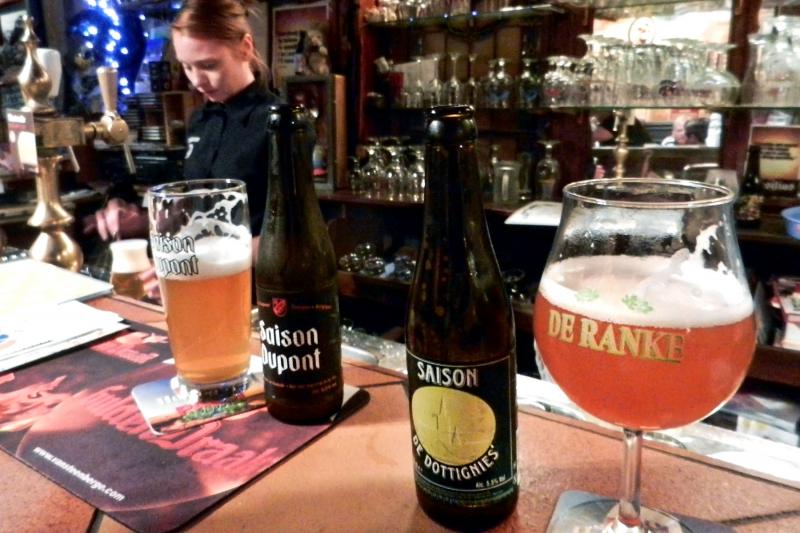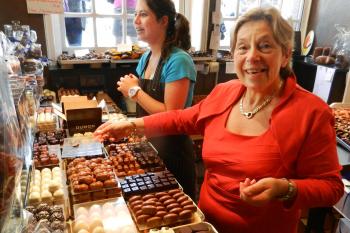Belgium's culinary highlights
Appears in the Online Edition, May 2019.
Whenever I think of Belgium, I recall digging into a dish of mussels while seated on a sunny square in Brussels, in the shadow of a lacy medieval spire. My waiter bragged, "In Belgium, we eat as hearty as the Germans and as fine as the French."
Wedged between Germany, France and the Netherlands, Belgium often gets lost in the mix. But this overlooked country rewards with some of Europe's finest cuisine, including the best beer, creamiest chocolates and tastiest french fries.
You'll find a good mix of both Germanic and French influences here. The Flemish (natives of Flanders -- now northern Belgium) were ruled by the dukes of Burgundy, and absorbed some of the fancy French cuisine of their overlords. And yet, once Belgian, always Belgian: They've perfected the art of cooking with their own unique beers, imbuing the cuisine with a hoppy sweetness.
Mussels are one of Belgium's signature dishes. The classic preparation is à la marinière, cooked in white wine, onions, celery, parsley and butter (though some cooks use light Belgian beer for the stock). For a high-calorie version, moules à la crème is thickened with heavy cream. You'll also find them served plain, with white wine, or in a tomato sauce (provencale). From about mid-July through April, you'll get the big Dutch mussels (most are from the coastal Zeeland area to the north). Locals take a break from mussels in May and June, when only the puny Danish kind are available.
The mussels come with another Belgian specialty on the side, frieten -- what we call "french fries" and the Dutch call "Flemish fries." In Belgium, fries are an art form. Just like every village in England has its "chippy" (for fish-and-chips), and every German burg has its wurst stand (for sausages), every Belgian town has a favored frietkot (fry shack). The fries are extra-delicious because they're deep-fried twice -- once to cook them and once to brown them. The best fries are cooked to a crisp in flavorful ox fat.
Traditionally, fries are generously topped with sauces like mayo (the most traditional), tartar sauce, curry ketchup, or currysaus (without the ketchup). Ketchup is sometimes available for the Yankees but I encourage you to skip it and go on a sauce adventure.
If you need something to wash down those mussels and fries, Belgium has you covered. It's right up there with Germany, England, and the Czech Republic as one of the world's great beer countries. Belgians take their beers as seriously as the French do their wines. And when it comes to variety, Belgium is number one, with hundreds of beer types and about 1,500 brands.
In general, Belgian beer is yeastier and higher in alcohol content than beers in other countries. Connoisseurs and novices alike can be confused by the many choices, and casual drinkers probably won't like every kind offered, since some don't even taste like beer. Locals in pubs are happy to educate you on the numerous options. You can also pay your respects to Belgian beer by taking a brewery tour; De Halve Maan Brewery in Bruges is one of the most accessible and enjoyable.
When you're ready for a sweet treat, indulge in Belgium's exquisite chocolates. The two basic types are pralines (what we generally think of as "chocolates" -- a hard chocolate shell with a filling) and truffles (a softer, crumblier shell with filling).
Belgians truly have a passion for chocolate. The people of Bruges, in particular, are connoisseurs; tempting chocolate-filled display windows are all over town. Katelijnestraat is "Chocolate Row," with a half-dozen shops within a few steps. While Godiva is the best big-factory/high-price/high-quality brand, plenty of smaller family-run places in Bruges offer handmade chocolates. Dumon makes perhaps Bruges' smoothest, creamiest chocolates, and their staff happily describe them with an evangelical fervor.
Save room for another sweet Belgian specialty -- waffles. You'll see little windows, shops, and trucks selling them either plain (for Belgians and purists) or topped with fruit, jam, chocolate sauce, ice cream, or whipped cream (for tourists). Belgians recognize two general types of waffles. The common take-out version is the dense, sugar-crusted, and very sweet Liege-style waffle, usually served warm. Brussels-style waffles are lighter and fluffier, dusted with powdered sugar, and sometimes topped with marmalade. Though Americans think of "Belgian" waffles as a breakfast food, Belgians generally have them as a late-afternoon snack.
Hungry? Belgium is ready for you. Like sampling a flavorful praline in a chocolate shop, that first enticing taste just leaves you wanting more. Go ahead, it's OK ... buy a whole box of Belgium.
(Rick Steves (www.ricksteves.com) writes European travel guidebooks and hosts travel shows on public television and public radio. Email him at rick@ricksteves.com and follow his blog on Facebook.)


